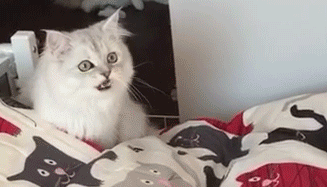It’s said that every kitten is a little spy sent by Cat Planet to take over Earth, sending signals back to their home planet at irregular intervals… Some send feedback through movements, others might secretly use tools, and there’s even a type that sends “telegrams” with rhythmic chattering sounds. But is this rhythmic “chatter” really how cats transmit information? Why exactly do they make this sound? Let’s dive into this mystery today!
-
The Variety of “Chattering” Sounds in Cats
Current research has found that cats can produce 21 different types of sounds, making them one of the animals with the broadest vocal ranges among carnivores. The “chattering” sound is one of these, and researchers have named it “chatter,” meaning “to chatter on” or “talk incessantly.” Some researchers have even classified this “chatter” into more specific types:Chattering: A series of short, unclear, rapid clicking sounds.Chirping: A high-pitched, sharp, and slightly repetitive sound similar to that of small birds or certain insects.Bird-like Chirp: A modulated bird call.But why do cats make this sound?
-
Four Theories About the “Chattering” Sound
Based on observations by cat owners, when cats produce the “chattering” sound, there is usually a bird or insect nearby. So, could they be doing this to catch their prey? After scouring the internet, we found four plausible theories:Theory 1: A “Vacuum Activity”.British zoologist Desmond Morris, in his book Cat Watching about feline behavior, suggested that chattering is a “vacuum activity,” which refers to behaviors that occur when an animal is unable to perform a physical action. In simpler terms, when a cat sees a bird or insect, it mimics the biting motions of hunting. This repetitive movement of the jaw joint produces the chattering sound.Theory 2: Mimicking Prey Calls.Some animal behaviorists believe that cats may mimic the sounds of their prey. In 2010, researchers found that jaguarundi cats in the Amazon would imitate the calls of their prey, such as the ocelot, in order to draw them closer and make them easier to catch. Similarly, cats may make “chattering” sounds to mimic birds or insects and trick them into coming closer.Theory 3: An Instinctive Reaction.Cat behavior consultant Marilyn Krieger believes that chattering may be an instinctive response. She suggests that when cats see prey, they might experience a “hunting thrill,” which triggers the release of dopamine and adrenaline, causing the cat’s mouth to tremble. This is similar to how some people may shake when excited.Theory 4: Negative Emotions.Animal behaviorist Shelley-Grielen thinks that chattering is a sign of a cat’s frustration or anger. Frania categorizes this as a form of “swearing” in cat language, often related to prey or food. For instance, when a bird lands outside a window, the cat may make “chattering” sounds as if cursing at the bird. Other behaviorists believe that the sound indicates the cat is frustrated because the prey is just out of reach. Ultimately, most of these behaviors reflect the cat’s negative emotions.In conclusion, the “chattering” sound is often a sign of the cat expressing frustration or agitation. It may even signal a need for intervention…

-
Noteworthy “Chattering” Behavior
1. Persistent “Chattering” Sounds.If a cat continuously makes the “chattering” sound for a long period, it could be a sign that the cat is experiencing anxiety and overstimulation. Over time, this may increase the cat’s aggression. When a cat can’t catch its prey, it can become frustrated, leading to anxiety. For example, this often happens when playing with a laser pointer. It’s recommended to pair the laser pointer with a physical object. When the cat “catches” the laser spot, reward it with a treat. If a cat spends too much time by the window, frequently making “chattering” sounds, it might help to pull the curtains to block the view or distract the cat with toys or food.2. Chattering Without Prey.As mentioned earlier, all the scenarios in which cats make “chattering” sounds are usually when they see prey. Therefore, if a cat makes the “chattering” sound when there’s no prey in sight, it is considered an abnormal behavior.
This could be related to oral or dental issues in cats. Cat owners should regularly check if there are any foreign objects in their cat’s mouth or if they show signs of pain, excessive drooling, bad breath, or loss of appetite. If any abnormalities are found, it’s important to take the cat to the vet for a checkup.And that’s another day of learning something new! Feel free to leave a comment or share pictures in the discussion section. Let’s exchange tips and experiences on cat care!





